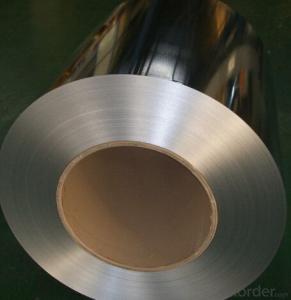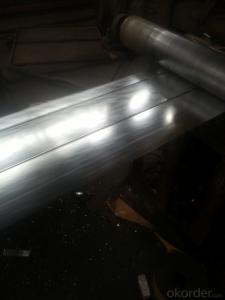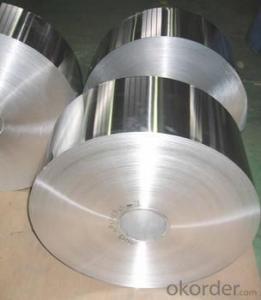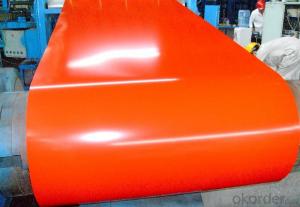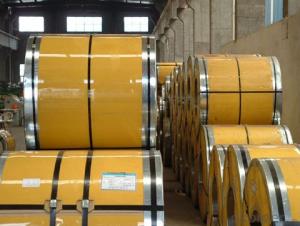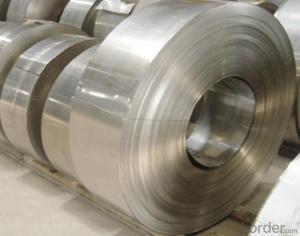Hot-dip Aluzinc Steel Coil From Chinese Shandong
- Loading Port:
- Tianjin
- Payment Terms:
- TT or LC
- Min Order Qty:
- 35 m.t.
- Supply Capability:
- 22222 m.t./month
OKorder Service Pledge
OKorder Financial Service
You Might Also Like
1.Description of the Hot-dip Aluzinc Steel:
Hot-dip aluzinc steel structure is composed of aluminum-zinc alloy, consisting of 55% aluminum, 43% zinc and 2% at 600 ℃ silicon solidification temperature and composition, the entire structure is made of aluminum - iron - silicon - zinc, to form a dense quaternary crystals an alloy.
Hot-dip aluzinc steel has many excellent features: strong corrosion resistance, is three times the pure galvanized sheet; zinc surface with beautiful flowers, can be used as a building outside board.
2.Applications of hot-dip aluzinc steel:
1)Building: roof, walls, garages, soundproof walls, pipes and modular housing.
2)Automotive: muffler, exhaust pipes, wiper accessories, fuel tank, truck boxes, etc.
3)Appliances: refrigerator back, gas stove, air conditioners, microwave oven, LCD frame,
4)CRT-proof band, LED backlight, electrical cabinets, etc.
5)Farm: barn, sheds, silos, piping and other greenhouse.
6)Other: breaking heat insulation cover, heat exchangers, dryers, warm water, etc.
3.Main Features of the Hot-dip Aluzinc Steel:
• Excellent corrosion resistance
• High temperature oxidation resistance
• High hot reflectance
• Good manufacturability
•Beautiful appearance
•Surface coating
•Cost-effective
4.Hot-dip Aluzinc Steel Images
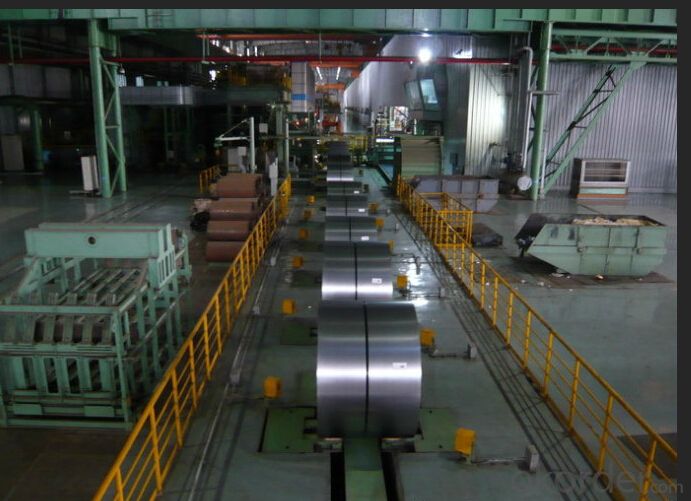
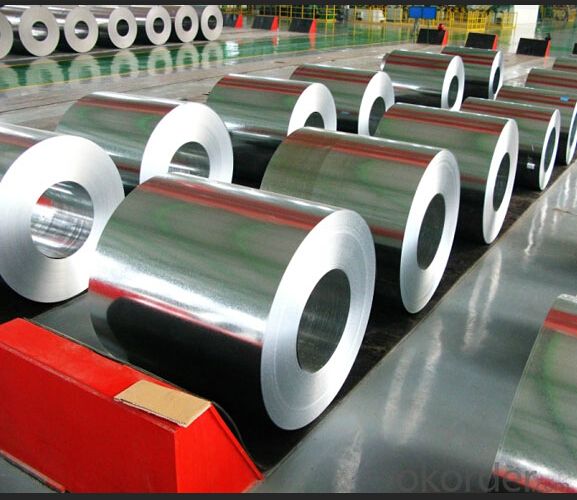
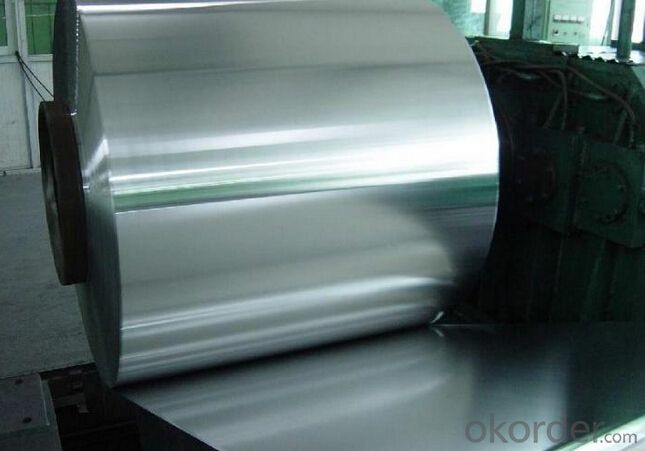
5.Hot-dip Aluzinc Steel Specification
AVAILABLE SPECIFICATION | HOT-DIP ALUZINC STEEL COILS |
THICKNESS | 0.16mm-3.5mm |
WIDTH | 1250mm MAX |
COATING MASS | 30 g/ m2-185 g/ m2 |
SPANGLE | Regular Spangle, Minimized Spangle, Zero Spangle |
SURFACE TREATMENT | Chromated / non-chromated, Oiled / non-oiled, Anti Finger Print |
COIL INNER DIAMETER | 508mm or 610mm |
HOT-DIP ALUZINC STEEL COILS | |||
COMMERCIAL QUALITY | ASTM A792M-06a | EN10327-2004 | JIS G 3321:2010 |
STRUCTURE STEEL | SS GRADE 230 SS GRADE 255 SS GRADE 275 SS GRADE 340 SS GRADE 550 | S220GD+AZ S250GD+AZ S280GD+AZ S320GD+AZ S350GD+AZ S550GD+AZ | SGLC400 SGLC440 SGLC490 SGLC570 |
6.FAQ of Hot-dip Aluzinc Steel
We have organized several common questions for our clients,may help you sincerely:
1) What advantages does your company have?
Cement : Annual capacity of 400 million tons, No. 1 in the world
Fiberglass: Annual capacity of 1 million tons fiberglass, No. 1 in the world.
Composite Materials — Carbon Fiber: Annual capacity of 10,000 tons PAN precursor and 4,000 tons carbon fiber, No. 1 in China
Composite Materials — Rotor Blade: Annual production capacity of 15,000 pieces, No.1 in China, Top3 worldwide
Glass: CNBM owns about 20 modern float glass product`ion lines, With annual capacity of 10 million square meters glass.
Light Weight Building Materials: Annual capacity of 1.65 billion square meters of gypsum board, No. 1 in the world.
Commercial concrete: Annual capacity of 0.35 billion cubic meters, No. 1 in the world.
Refractory Material: Annual capacity of 40,000 tons casting refractory, No.1 in the world.
2) What advantages do your products have?
Firstly, our base material is of high quality, Their performance is in smooth and flat surface,no edge wave ,good flexibility.
Secondly, high quality zinc ingoats, 97.5% zinc,1.5% silicon,1% others, the same zinc coating measured by metal coating thickness or by zinc weight
Thirdly, high precision: Tolerance strictly according to ASTM or JISG standard even more rigid.
We have full stes of testing equipment(for t best, cupule,chromatism,salt spray resistance, etc) and professional engineers.
3) Could you let me approach about your company in Dubai?
Located at Jebel Ali Free Zone in Dubai, CNBM Dubai Logistics Complex is adjacent to -Jebel Ali sea port-the largest port in UAE and Al Maktoum Airport-the largest airport in the world, which covers an area of 50,000 square meters, including an fully enclosed warehouse by 10,000 square meters, an open yard by 25000 square meters, and 13 standard unloading platform. CNBM Dubai Logistics Complex formally put into operation on August 1, 2013. Dubai Logistics Complex will commit itself to build the most professional and most influential building materials distribution center of China’s building materials industry in the UAE and throughout the Middle East and Africa.
- Q:What are the future prospects for the steel strip industry?
- The steel strip industry has a promising future ahead. Despite facing challenges in recent years such as overcapacity and trade disputes, there are several factors indicating a positive outlook. To begin with, the global increase in construction and infrastructure development activities is expected to drive the demand for steel strips. These strips are extensively used in various construction applications like roofing, flooring, and cladding. As countries continue to invest in infrastructure building and modernization, the demand for steel strips is likely to rise. Furthermore, the automotive industry, a major consumer of steel strips, is undergoing a transformation with the emergence of electric vehicles and autonomous driving technologies. This shift necessitates the production of lightweight and high-strength materials, including steel strips, to meet the changing needs of the industry. Consequently, the steel strip industry is expected to benefit from the demand for advanced materials in the automotive sector. Additionally, the increasing emphasis on sustainable and eco-friendly practices is expected to drive the adoption of steel strips. Steel is a recyclable material that can contribute to reducing carbon emissions and achieving sustainability goals. This trend is likely to fuel the demand for steel strips as companies and governments prioritize environmental responsibility. Moreover, advancements in technology and manufacturing processes are expected to enhance the efficiency and quality of steel strip production. This will result in cost reductions and increased productivity, making steel strips more competitive in the market. However, it is crucial to acknowledge that the steel strip industry will still face challenges. Fluctuations in raw material prices, trade barriers, and competition from alternative materials like aluminum and composites can affect the industry's growth. Additionally, the industry needs to address sustainability concerns and invest in research and development to innovate and meet the evolving demands of various sectors. In conclusion, the future prospects for the steel strip industry are positive. With the increasing demand from the construction and automotive sectors, the growing focus on sustainability, and advancements in technology, the industry is well-positioned for growth. However, it must adapt to changing market dynamics and invest in innovation to remain competitive in the global marketplace.
- Q:What are the different types of edge conditions for steel strips?
- Steel strips can have different edge conditions depending on their specific application requirements. Some common types are as follows: 1. The standard edge condition, known as the mill edge, is produced during the steel manufacturing process. It is characterized by a slightly rounded or rolled edge resulting from hot or cold rolling. 2. The slit edge condition involves slitting the steel strip to the desired width using a slitting machine. The edges in this condition are generally sharp and may have burrs or irregularities. 3. After slitting, the edges of the steel strip can be deburred to remove any sharp edges or burrs. This is typically done using machines or tools to ensure safer handling and prevent damage to subsequent processes or equipment. 4. Rounded edges are required in certain applications to prevent damage or injury. The edges can be machined or rolled to achieve a smooth, rounded profile. 5. Beveled edges are commonly used when two steel strips need to be joined together, such as in welding or butt joint applications. The edges are machined to have a specific angle or bevel, enabling easier and stronger welding or joining. 6. Customized edge conditions can be provided to meet specific requirements. These may include special edge profiles, chamfered edges, or unique finishes to fulfill design or functional needs. It's worth noting that the choice of edge condition depends on factors such as the intended use, processing requirements, and budget considerations. Seeking guidance from steel suppliers or manufacturers can help determine the most suitable edge condition for a particular application.
- Q:What are the common maintenance practices for steel strips?
- Common maintenance practices for steel strips include regular cleaning, lubrication, and inspection. Cleaning is an important maintenance practice for steel strips as it helps to remove dirt, debris, and other contaminants that can accumulate on the surface. This can be done using a mild detergent or a specialized cleaner that is designed for steel surfaces. It is important to avoid using abrasive cleaners or tools that can scratch or damage the steel. Lubrication is another critical maintenance practice for steel strips, especially if they are used in moving parts or machinery. Applying a suitable lubricant helps to reduce friction and wear, ensuring smooth operation and extending the lifespan of the steel strips. The type of lubricant used will depend on the specific application and the requirements of the equipment. Regular inspection is essential to identify any signs of damage or wear on the steel strips. This can include checking for cracks, dents, or any other abnormalities that may affect their performance or structural integrity. Any issues should be addressed promptly to prevent further damage and potential safety hazards. Additionally, it is important to store steel strips properly to prevent rust or corrosion. This can be achieved by keeping them in a dry and well-ventilated area, away from moisture or chemicals that can cause damage. Applying a protective coating or using rust inhibitors can also help to prevent corrosion. Overall, by following these common maintenance practices, steel strips can be kept in good condition, ensuring their optimal performance and longevity.
- Q:What is the typical width range of steel strips?
- The typical width range of steel strips can vary depending on the specific application, but it generally falls between 0.5 inches to 36 inches.
- Q:How do steel strips perform in heat exchangers?
- Steel strips perform well in heat exchangers due to their excellent thermal conductivity and durability. They efficiently transfer heat between fluids, ensuring effective heat exchange. Additionally, steel strips can withstand high temperatures and pressures, making them reliable in demanding operating conditions commonly found in heat exchangers.
- Q:How are steel strips used in the production of automotive parts?
- Steel strips are commonly used in the production of automotive parts due to their strength, durability, and versatility. These strips are typically made from high-quality steel alloys that are specifically designed to meet the demanding requirements of the automotive industry. One of the primary applications of steel strips in automotive part production is in the manufacturing of body panels. These panels, such as doors, hoods, fenders, and roofs, require materials that can withstand impacts, resist corrosion, and provide structural integrity. Steel strips are an ideal choice for these components as they offer excellent strength-to-weight ratio, ensuring the safety and performance of the vehicle. Steel strips are also used in the production of structural components like chassis frames and suspension systems. These parts need to be able to handle heavy loads, endure harsh road conditions, and provide stability. Steel strips provide the necessary strength and rigidity to these components, ensuring the overall structural integrity of the vehicle. In addition to body panels and structural components, steel strips are employed in the production of smaller automotive parts as well. These include brackets, reinforcements, supports, connectors, and various other components that require high strength and dimensional accuracy. Steel strips can be easily cut, formed, and welded to create complex shapes and designs, making them a preferred material in the automotive industry. Furthermore, steel strips are often used in the production of safety-related automotive parts such as seatbelt buckles, door latches, and airbag components. These parts require materials that can withstand extreme forces and provide reliable performance in critical situations. Steel strips offer the necessary strength, toughness, and resistance to deformation, ensuring the safety of passengers in case of accidents. Overall, steel strips play a vital role in the production of automotive parts by providing strength, durability, and versatility. Their usage in body panels, structural components, smaller parts, and safety-related components contribute to the overall performance, safety, and longevity of vehicles.
- Q:How do steel strips compare to other materials in terms of strength?
- Steel strips are known for their exceptional strength and are widely regarded as one of the strongest materials available. Compared to other materials, such as aluminum or plastic, steel strips offer superior strength and durability, making them highly desirable for various applications where structural integrity is crucial.
- Q:Can steel strips be recycled after use?
- Yes, steel strips can be recycled after use. Steel is one of the most recycled materials in the world due to its durability and high recyclability. When steel strips are no longer needed or reach the end of their useful life, they can be collected and sent to a recycling facility. The recycling process begins with sorting and separating the steel strips from other materials. The strips are then cleaned to remove any contaminants. After cleaning, the steel strips are shredded into smaller pieces and melted down in a furnace. The molten steel is then cast into new steel products or rolled into new steel strips. Recycling steel strips has several benefits. Firstly, it helps conserve natural resources as it reduces the need for mining iron ore, the primary raw material used in steel production. Additionally, recycling steel helps save energy as the production of recycled steel requires less energy compared to producing steel from scratch. Recycling steel also helps reduce greenhouse gas emissions and air pollution associated with steel production. Moreover, the recycled steel retains its inherent properties, making it just as strong and durable as virgin steel. This means that the recycled steel strips can be used for similar applications as their original counterparts, such as in construction, automotive, and manufacturing industries. In conclusion, steel strips can indeed be recycled after use. Recycling steel strips promotes environmental sustainability, conserves resources, saves energy, and reduces pollution. It is an important practice that contributes to a circular economy and should be encouraged to minimize waste and maximize the lifespan of steel materials.
- Q:What are the advantages of cold rolling and cold rolling strip steel?
- Cold rolled steel strip and sheet thickness is generally 0.1 ~ 3mm, width 100 ~ 2000mm in hot strip steel or timber as raw material, under normal temperature after cold rolling, cold rolled steel strip and sheet has the advantages of smooth surface, smooth, high precision and good mechanical properties.
- Q:Can steel strips be used in the production of agricultural machinery?
- Yes, steel strips can be used in the production of agricultural machinery. Steel strips are often used to fabricate components such as brackets, supports, and reinforcements due to their durability, strength, and resistance to corrosion. These properties make steel strips suitable for withstanding the heavy use and demanding conditions encountered in agricultural machinery.
1. Manufacturer Overview |
|
|---|---|
| Location | |
| Year Established | |
| Annual Output Value | |
| Main Markets | |
| Company Certifications | |
2. Manufacturer Certificates |
|
|---|---|
| a) Certification Name | |
| Range | |
| Reference | |
| Validity Period | |
3. Manufacturer Capability |
|
|---|---|
| a)Trade Capacity | |
| Nearest Port | |
| Export Percentage | |
| No.of Employees in Trade Department | |
| Language Spoken: | |
| b)Factory Information | |
| Factory Size: | |
| No. of Production Lines | |
| Contract Manufacturing | |
| Product Price Range | |
Send your message to us
Hot-dip Aluzinc Steel Coil From Chinese Shandong
- Loading Port:
- Tianjin
- Payment Terms:
- TT or LC
- Min Order Qty:
- 35 m.t.
- Supply Capability:
- 22222 m.t./month
OKorder Service Pledge
OKorder Financial Service
Similar products
New products
Hot products
Related keywords




